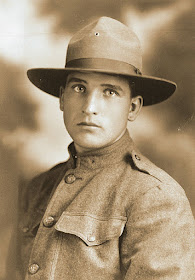Contributed by Tom Boltz
 |
| U.S. Army Private Vernon Wymer 1900–1918 |
Vernon Wymer was the first Wood County, Ohio, serviceman to die in combat in World War I. He did not win any medals or receive any national recognition; however, his story is important because he is representative of the thousands of soldiers from small Mid-Western towns who perished in WWI.
The Bowling Green Sentinel-Tribune, a local newspaper, ran recruiting ads like the one on the left free of charge for the National Guard.
Shortly after America’s entry into the war in April 1917, National Guard Units throughout the U.S., in anticipation of mobilization, began recruiting efforts. The closest National Guard unit to North Baltimore, Ohio, where Vernon Wymer was living was Company H, 2nd Ohio Infantry Regiment, located in Bowling Green, the county seat.
In May 1917, Company H was significantly under strength and needed to recruit over 64 men to reach its authorized wartime strength of 150. The unit officers began an intensive recruiting campaign throughout the county’s small towns, and local officials aided by sponsoring patriotic meetings to encourage young men to volunteer. Responding to these pleas, Wymer, along with several of his friends, went to Bowling Green and enlisted as a private in the unit on 26 July.
 |
| In this 14 August 1917 picture of some Company H members, Vernon Wymer (second row, sixth from left) and the other new recruits have not yet been issued uniforms. |
Although Company H was activated for Federal service on 2 August, Wymer and the rest of the company remained at the local armory for several weeks. During this time, the unit conducted what training it could despite a severe shortage of equipment and weapons. Although the recruiting campaign brought in many new guardsmen, the unit was still under strength. In mid-September, the 135 men in the unit left Bowling Green for Camp Sheridan, a training camp in Alabama. There conscripts were assigned to bring the unit up to full strength. Company H was later re-designated as Company E, 146th Infantry Regiment, 37th Infantry Division.
 |
| This peaceful French wheat field in 2013 was the site where Private Vernon Wymer was killed on 2 July 1918 when his unit attacked the German troops that occupied the village of Vaux (left center). |
Wymer trained with the 146th Infantry until early May 1918 when he was re-assigned as a replacement to the American Expeditionary Force in France. After arriving in France in June, Wymer was eventually assigned to the 2nd US Infantry Division as a rifleman with Company K, 23rd Infantry Regiment. During the Defense of the Marne River Line Campaign, Private Wymer was killed during the Battle of Vaux on 2 July 1918 while his unit was attacking German units holding the village of Vaux.
 |
| In this 2014 photograph, Vernon’s and Gerald’s graves are marked by an American flag. Such flags are placed there each Memorial Day by the local American Legion Post. |
At the request of his family, Private Wymer’s body was returned to the United States for burial in 1921. An estimated 4,000 people attended his funeral in North Baltimore, Ohio. No North Baltimore-area service members killed in action in World War II or later wars has received such a significant tribute for their ultimate sacrifice for their country. Vernon Wymer’s grave can be found in a quiet rural cemetery in Wood County, Ohio. His youngest brother Gerald, who was killed in action in Belgium during World War II, is buried beside him.


Sad, for two brothers to die in battle twenty-nine years apart fighting the same enemy.
ReplyDeleteApparently he enlisted when he was 17? I didn't know that the US Army took any men under 18. The British were another matter entirely.
ReplyDeleteThe Canadian army also enlisted those who were 17, my current list shows 16 Americans who were also KiA serving in varying Canadian regiments.
ReplyDeleteWilliam Zorn, a native of North Baltimore Ohio, enlisted in the Canadian Army (Company C, 10th Battalion, 1st Canadian Division) at the start of the war and was wounded on the Western Front. He returned to his native hometown and helped in the recruitment of Vernon Wymer. Taking in their German surnames and how a mob from a local saloon broke into the school and burned German language books, one can only assume.
ReplyDelete